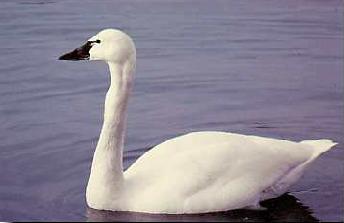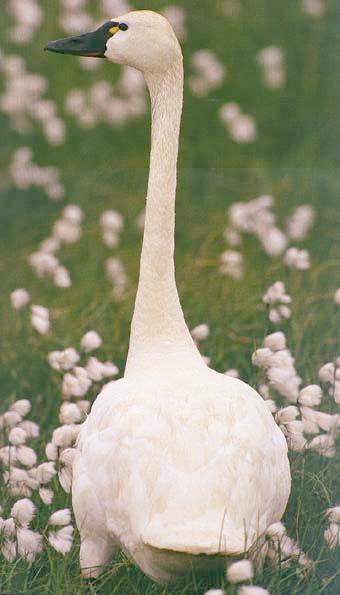

If you're lucky enough to see a flock of Tundra swans migrating on a cold, clear night, their wings translucent against a full moon, you'll not soon forget the sight. "Long Point Country" ( 8.1 Staging ), has long been use to the spectacular spring arrival of the Tundra Swans or as they use to be called "Whistling Swans" when they migrate North to their breeding grounds and again as they fly South toward their wintering place. They are an all white swan, with black feet and a black bill that has a small yellow spot at the base of the upper mandible. This swan holds its neck straight up, unlike the Mute Swan which bends its neck in a graceful curve. They have a mellow, rich bugling call. The voice of the Tundra Swan is soft and melodious. The species' former name “whistling swan” referred to the sound made by the slow, powerful beating of the wings in flight, and not to the voice of the bird. As flocks pass overhead, the leader often utters a high note like "who-who-who," which is immediately repeated by flock after flock, producing a high-pitched whistling sound. The call is pitched lower than a whistle and more closely resembles a blowing or tearing sound and can be heard for up to six kilometres. The Tundra Swan breeds in the Canadian North in the tundra areas of Hudson's Bay west to Alaska and winters in the Chesapeake Bay marshes of the United States.
Classification
|
Identification:

Large, long-necked waterbird with short legs and a short duck-like bill.
Long neck held straight up with a kink at base.
Adult:
Black bill with variably-sized yellow spot at base.
Culmen somewhat concave.
Black of bill extends up to eye but does not encircle it.
Straight demarcation on forehead between black bill and white feathering.
Black legs and feet.
Entirely white plumage, when it is feeding in iron-rich areas, the feathers on its head and neck may take on a reddish tinge.
Sexes similar; The male weighs on average 7.5 kg and can measure 1.3 m from bill to tail. The adult female is about the same size as the male but weighs slightly less, about 6.3 kg.
Immature:
The young of the year are smaller than the adults and have gray plumage, pinkish beaks with black tips, and pink legs and feet. It takes at least two years for adult plumage to grow in.
Length and wingspan from: Robbins, C.S., Bruun, B., Zim, H.S., (1966). Birds of North America. New York: Western Publishing Company, Inc.
This swan is slightly smaller than the Trumpeter Swan and usually has a small yellow or orange spot at the base of the upper mandible. When at rest, it holds its neck straight up, rather than curved backwards.
Similar species:
The very large Tundra Swan is unlikely to be confused with anything but other swans. White Pelicans, Whooping Cranes, Wood Storks, and Snow Geese are all white birds that from a great distance could look like swans but all have black primaries. The adult Mute Swan can be told from the adult Tundra Swan by its orange and black knobby bill. The adult Trumpeter Swan is very similar to the adult Tundra Swan but it is slightly larger, has a straight culmen, the bill has no yellow spot, the eye is enclosed by black, and the white feathering on the head extends in a v shape into the dark bill. In the far northwest, a subspecies of the Tundra Swan shows more yellow at the base of the bill and could be confused with the Alaskan Whooper Swan. The Whooper Swan has yellow in the bill that goes beyond the nostril.
Related species:
There are seven species of swans in the world. Two of these, the Tundra Swan Cygnus columbianus and the Trumpeter Swan (Cygnus buccinator), are native to North America; their respective populations comprise 140 000 and 16 000 individuals. The Trumpeter Swan is a native of the interior portions of North America, historically nesting and wintering from the upper Mississippi Valley west and north to central Alaska. One nonnative species is found in North America, the Mute Swan. The Mute Swan (Cygnus olor) is an exotic species introduced from Europe and now found in parts of eastern U.S.; it has an orange bill with a black base and knob in front of the eyes. People brought Mute Swans from Europe and Asia for ornamental display in parks and zoos, and now this species is found in the wild in certain parts of the continent.
The most distinctive difference is the voice. The Trumpeter Swan has a deep, resonant, brassy, trumpet-like voice; the voice of the Tundra Swan is softer and more melodious. The species' former name “whistling swan” referred to the sound made by the slow, powerful beating of the wings in flight, and not to the voice of the bird. The call is pitched lower than a whistle and more closely resembles a blowing or tearing sound.

Tundra Swans are the largest and one of the most inspiring birds of the Arctic. Visitors flying over the swan's tundra nesting grounds readily spot them, as they appear as miniature icebergs adrift on the numerous lakes and ponds dotting the landscape. Seeing a flock of swans migrating on a cold, clear night looking like graceful ghosts with translucent wings against a full moon is a truly memorable sight. Few birds stir the imagination more than these. The swans on the Arctic coastal plain of Alaska are part of the Eastern Wintering Population of the Tundra Swan, which winters around the Chesapeake Bay south to the Carolinas. The swans fly 3,500-4,200 miles from Alaska to the East Coast.
Distribution:
The Tundra Swan is composed of two subspecies: Bewick's Swan (Cygnus columbianus bewickii)of the Old World and the Whistling Swan (Cygnus columbianus columbianus) of the New World. Both nest on the Arctic and subarctic tundra, with the latter nesting from SW Alaska around the Arctic coast, east to Baffin Island and south to Hudson Bay. Both subspecies winter in the North Temperate Zone. Whistling Swans and winter in two distinct population segments. Birds nesting in western Alaska from the Point Hope and Cape Lisburne region southward to Kodiak.